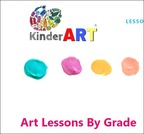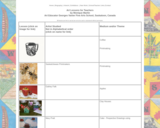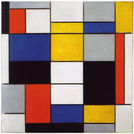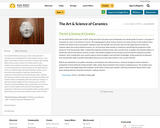
These short videos teach about famous artists and art styles.
- Subject:
- Arts Education
- Visual Arts
- Material Type:
- Activity/Lab
- Author:
- Art History for Kids!
- Date Added:
- 09/16/2024

These short videos teach about famous artists and art styles.

This lesson has students creating a self portrait using image and text.
This lesson can be completed in Art & ELA.
Morphology of the word micrography – micro – small; graphy -writing – students use small writing to create portraits!
Students will need to have a good understanding of self to create their portrait. Ideas could include words to describe the student, phrases, quotes, song lyrics, family members, poetry, or random thoughts. Some students may need guidance as to what information to include (or a model).
Sun West - Contact your school’s technology coach if require help with the technology piece of this lesson.
Extension – this lesson could be extended further into Social Studies or ELA by having students complete micrography portraits of historical figures, indigenous leaders, scientists or characters from novels or stories they are studying.
Multiage - Grade 4 students could complete this activity for prairie landscapes & Grade 5 students could complete this on pop art.

Here you can browse through art lesson plans by age or grade, from Preschool through High School.
The site includes a "What you can expect" of students artists at each age level.
At KinderArt "Our mission is to create and provide art lesson plans that parents and teachers can use in their home and school classrooms. We aim to offer ideas that make use of readily available materials that won't break the bank."

Art Lessons for Teachers
by Monique Martin
Art Educator Georges Vanier Fine Arts School, Saskatoon, Canada
Includes: printmaking, sculpture, perspective drawing, colours, mixed media, chair design, clay, architecture, cultural art, drawing, painting, quilting, and much more!

Some great visual resources that meet outcomes from the grade 6 curriculum.

The culminating art and writing projects for each of the Comox Valley Schools (SD71, B.C.) middle-grade Core French units (also searchable on the Resource Bank). All would be adaptable for younger and older students. These could also been done as separate assignments, but are best scaffolded by the activities in each unit!
/
Ces projets d'art et de rédaction sont destinés aux élèves de Core French, mais pourraient également être utiles dans des cours d'Immersion!
UNIT THEMES (those with art/writing projects, searchable on the Resource Bank):
-Greetings & letters (saluer & alphabet)
-Numbers & calendar (chiffres & calendrier)
-Who are you? (Qui es-tu?)
-Body parts & monsters (le corps & les monstres)
-Clothing (les vêtements)
-Sports (les sports)
-Hobbies (les passe-temps)
-Animals (les animaux)
-High-frequency words (Les mots de haute fréquence)
-Food (la nourriture) - unit 2/2e unité

For the 2014/2015 school year at KCS, all the Arts Ed 9 outcomes were intergraded into all the grade 9 courses. I was given 4 outcomes to cover in my Science 9 course. My ongoing goal in all my science classes is to relate science to the student’s lives and the real world as much as possible. Having to cover the specific arts outcome gave me the opportunity to teach my students about the science behind ceramics, an art form that relies heavily on chemistry, specifically the properties of the elements from the periodic table. I utilized the expertise of Devon Coles, who runs the local art gallery, the Garden Gallery, in Kindersley where he produces ceramics, to give the students insight into his ceramics process and the chemistry involved. Students then created their own ceramics pieces at the art gallery and used their knowledge of the properties of elements from the periodic table to predict which glaze Devon put on their piece before it was cured in the kiln.

Watch videos that will allow you to visit these amazing works of art from the comfort of your device!

This collection of art videos will support teachers and students in their quest to learn more about art.
Videos include: Matisse, Chagall, Michelangelo, pointillism, Britto, Chinese Dragon, Dali, Pollock, Tin Art, Kindness Rocks, Landscapes, Fashion Design, Collaborative Portraits, Zentangle, Howard, Dhurrie Rug, Magritte.
There are great ideas for lessons here, information about famous artists and great individual or collaborative projects.

Students will learn about the jazz singer Billie Holiday and the sociohistorical context in which she performed. They will learn how discriminatory statutes (called Jim Crow laws) affected daily life. They will also analyze how movement is created in photographs and the effect of a photographer's point of view on composition. Finally, students will photograph a musician, paying attention to what can be communicated through point of view.

Students will discuss a page from a late-medieval choir book, including its function and how it was made. They will learn how music was notated in the Middle Ages and practice a simplified method of notating music. Working in teams, students will create a class choir book of songs of celebration.

Students will discuss the form, function, and decoration of an ancient Greek wine cup. They will learn about the importance of music in the daily life of ancient Greeks. They will discuss a page from a late-medieval choir book and compare and contrast the role of music in antiquity, the Renaissance, and today. They will create cups for a social gathering inspired by ancient Greek symposia, and create and perform a song, poem, or story.

Students will analyze scenes from the Trojan War that are visually depicted in an ancient object and an 18th-century painting. They will research an epic poem inspired by the Trojan War and write a literary response analyzing how themes and values in the poem reflect the historical context in which they were made. Finally, they will work in teams to reframe a tale from the Trojan War in a contemporary context -- visually and in poetry -- and recite the tale in a poetry slam.

Students will discuss what is communicated in an ancient statuette by analyzing the size and poses of two figures. They will learn that stories were passed through oral tradition in ancient times. They will create sculptures of themselves, a companion, and a favorite musical instrument using spheres and cylinders, and then recite a story inspired by their sculptures.

Students will learn about the Trojan War and the hero Achilles. They will compare different stories that were inspired by Achilles, which were passed down orally. They will analyze stories of Achilles in a relief on an ancient sarcophagus and in a drawing by a Renaissance artist. Finally, they will create their own drawing of Achilles inspired by literature.

Students will examine three works of art to learn about the daily lives of working ballet dancers in Paris in the 19th century. Students will conduct additional research to learn about the cultural context at the time these dancers worked, including how ballet dancers were perceived. Finally, students will create a backstage view of a contemporary dancer.

Students will learn about an artist's sketchbook that includes drawings of ballet dancers. They will practice two ballet steps and discuss how an artist uses line to depict dancers in rehearsal. Students will make a sketchbook and produce a series of quick sketches of dancers.

Students will learn about axial movements and locomotor movements by discussing dancers depicted in a drawing and photograph. They will then practice combining axial and locomotor movements. They will describe how artists depict a dancer's motion in drawing and photography. They will also analyze how an artist creates movement and emphasis through contrast, composition, and leading lines, and then experiment with photography to capture motion in dance.

Students will learn about the Impressionist painters' use of color and how it connected to early-19th-century scientific theories about color. They will explore combinations of primary and secondary colors, experiment creating secondary colors, and create a landscape using complementary colors.

"Many artists create work that intersects with political activism and social justice causes. Throughout history, art has been used as an accessible tool for communication, raising awareness about social issues and affecting positive change. This video collection will introduce students to artists who create work that inspires dialogue about problems faced by communities around the world, and will provide inspiration for classroom projects with a social, public or political purpose."